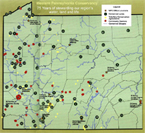|
Conserve |
|
| Conserve 75th Anniversary Commemorative Issue |
| 1930s - 40s |
| 1950s |
| 1960s |
| 1970s |
| 1980s |
| 1990s |
| 2000s |
| Fall 2007 Home |
| Past Issues |

Message from the President
Thomas Saunders
President and CEO
 An important question for conservation
organizations is what constitutes truly effective
conservation. For our work to be meaningful
to the future of western Pennsylvania next year and
75 years from now, our conservation decisions need
to be soundly formed and guided by what will do the
most for our region in the long run.
An important question for conservation
organizations is what constitutes truly effective
conservation. For our work to be meaningful
to the future of western Pennsylvania next year and
75 years from now, our conservation decisions need
to be soundly formed and guided by what will do the
most for our region in the long run.
Here at the Western Pennsylvania Conservancy, through the hard work of our staff, our more than 4,000 volunteers, and the support of our members, we are taking steps in a number of key directions that will protect the environment and quality of life in our region and enhance the qualities that make it so special.
Our work in land protection continues to be both thoughtful and deliberative as we prioritize the best lands and waters to protect. We are also practical and agile, working rapidly to arrive at voluntary land protection strategies that protect important properties for future generations. To date, the Conservancy has protected more than 214,000 acres of land and more than 500 miles of streams and rivers. We've partnered with like-minded organizations, landown ers and community groups to save those lands and waters that are most important to the life of our region. Most recently, we have developed a conservation blueprint, built on data and research, which helps us identify priority properties based on their large-scale landscape values and their individual resource values. The Conservancy works through its Natural Heritage inven tory program, Freshwater Conservation program, natural resources research and land protection work to preserve and enhance these natural resources so that our region will always remain special.
Another component of conservation is to work with our existing built communities - Pittsburgh and the smaller communities in our region - to take steps toward keeping them livable and attractive. The Conservancy's Com munity Gardens and Greenspace program enhances our communities with open spaces and botanical beauty in order to help our communities continue to thrive. The Conservancy is providing approximately 80 planted gardens in the city and more than 400 smaller plantings in downtown alone. With extraordinary assistance from volunteers, the Conservancy provides 140 open spaces planted with perennials and blooming annuals to enhance the beauty of communities in 19 counties throughout our region.
And conservation means preserving the best of the best - and not just
conserving but sharing, teaching, and learning in those best of the best
settings. Just as our in-house conservation research and our partnerships
lead us toward protection of our most important natural resources, the Conservancy preserves our region's remarkable asset of Frank Lloyd Wright's
Fallingwater. Each year, more than 135,000 visitors from this region and
around the world come to Fallingwater and appreciate Bear Run, the Laurel
Highlands, and this exquisite property, all unique to our region.
As the new President of the Western Pennsylvania Conservancy, I am
pleased to join and lead an organization that understands conservation in all
its breadth. This organization works to protect the most significant of our
region's rural open spaces, to enhance our existing communities, and to
preserve and protect one of the world's great architectural gems so that we
may cherish it and learn from it every day.
The pages that follow offer a glimpse of the conservation work accom
plished by the Conservancy over its rich 75-year history, as we look back on
our conservation accomplishments and look ahead to work yet to be done.